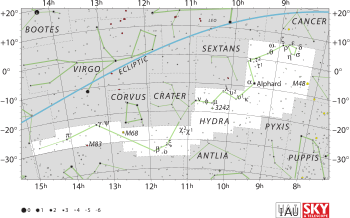Nu Hydrae
Nu Hydrae, Latinized from ν Hydrae, is an orange-hued star in the constellation Hydra, near the border with the neighboring constellation of Crater. It has an apparent visual magnitude of 3.115,[2] which is bright enough to be seen with the naked eye. Based upon parallax measurements, this star is located at a distance of about 144 light-years (44 parsecs) from the Earth.[1]
 | |
| Observation data Epoch J2000 Equinox J2000 | |
|---|---|
| Constellation | Hydra |
| Right ascension | 10h 49m 37.48875s[1] |
| Declination | –16° 11′ 37.1360″[1] |
| Apparent magnitude (V) | 3.115[2] |
| Characteristics | |
| Spectral type | K0/K1 III[3] |
| U−B color index | +1.305[2] |
| B−V color index | +1.239[2] |
| Astrometry | |
| Radial velocity (Rv) | –1.2[4] km/s |
| Proper motion (μ) | RA: +93.35[1] mas/yr Dec.: +198.88[1] mas/yr |
| Parallax (π) | 22.69 ± 0.23[1] mas |
| Distance | 144 ± 1 ly (44.1 ± 0.4 pc) |
| Absolute magnitude (MV) | −0.11[5] |
| Details | |
| Mass | 2.0[6] M☉ |
| Radius | 21[7] R☉ |
| Luminosity | 151[7] L☉ |
| Surface gravity (log g) | 2.3[7] cgs |
| Temperature | 4,335[7] K |
| Metallicity [Fe/H] | –0.30[7] dex |
| Rotational velocity (v sin i) | 5.3[7] km/s |
| Other designations | |
| Database references | |
| SIMBAD | data |
The spectrum of this star matches a stellar classification of K0/K1 III,[3] where the luminosity class of 'III' indicates this is a giant star that has exhausted the supply of hydrogen at its core and evolved away from the main sequence. The radius of this star has expanded to 21 times the Sun's radius[7] with an emission of about 151 times the luminosity of the Sun.[7] This expanded outer envelope has an effective temperature of about 4,335 K,[7] giving it the characteristic orange hue of a K-type star.[9]
Nu Hydrae is an X-ray emitter with an estimated luminosity of 6.6 × 1028 erg s−1 in the X-ray band.[6] The abundance of elements other than hydrogen and helium, what astronomers term the star's metallicity,[7] is about half that in the Sun.[lower-alpha 1] It has a relatively high proper motion across the celestial sphere,[8] suggesting that it has a peculiar velocity roughly three times higher than its neighbors.[10]
Nu Hydrae was a later designation of 4 Crateris.[11]
Notes
- The actual abundance of metals relative to the abundance in the Sun can be derived by taking the metallicity estimate to the power of ten, thus:
- 10[Fe/H] = 10−0.30 = 0.50
References
- van Leeuwen, F. (November 2007), "Validation of the new Hipparcos reduction", Astronomy and Astrophysics, 474 (2): 653–664, arXiv:0708.1752, Bibcode:2007A&A...474..653V, doi:10.1051/0004-6361:20078357
- Gutierrez-Moreno, Adelina; et al. (1966), "A System of photometric standards", Publications of the Department of Astronomy University of Chile, Publicaciones Universidad de Chile, Department de Astronomy, 1: 1–17, Bibcode:1966PDAUC...1....1G
- di Benedetto, G. P. (November 1998), "Towards a fundamental calibration of stellar parameters of A, F, G, K dwarfs and giants", Astronomy and Astrophysics, 339: 858–871, Bibcode:1998A&A...339..858D
- Wielen, R.; et al. (1999), "Sixth Catalogue of Fundamental Stars (FK6). Part I. Basic fundamental stars with direct solutions", Veroeffentlichungen des Astronomischen Rechen-Instituts Heidelberg, Astronomisches Rechen-Institut Heidelberg, 35 (35): 1, Bibcode:1999VeARI..35....1W
- Anderson, E.; Francis, Ch. (2012), "XHIP: An extended hipparcos compilation", Astronomy Letters, 38 (5): 331, arXiv:1108.4971, Bibcode:2012AstL...38..331A, doi:10.1134/S1063773712050015.
- Gondoin, P. (December 1999), "Evolution of X-ray activity and rotation on G-K giants", Astronomy and Astrophysics, 352: 217–227, Bibcode:1999A&A...352..217G
- Massarotti, Alessandro; et al. (January 2008). "Rotational and Radial Velocities for a Sample of 761 HIPPARCOS Giants and the Role of Binarity". The Astronomical Journal. 135 (1): 209–231. Bibcode:2008AJ....135..209M. doi:10.1088/0004-6256/135/1/209.
- "LTT 3973 -- High proper-motion Star", SIMBAD, Centre de Données astronomiques de Strasbourg, retrieved 2012-01-13
- "The Colour of Stars", Australia Telescope, Outreach and Education, Commonwealth Scientific and Industrial Research Organisation, December 21, 2004, archived from the original on December 3, 2013, retrieved 2012-01-16
- Kaler, James B., "Nu Hydrae", Stars, University of Illinois, retrieved 2012-01-13
- Wagman, M. (August 1987). "Flamsteed's Missing Stars". Journal for the History of Astronomy. 18 (3): 215. Bibcode:1987JHA....18..209W. doi:10.1177/002182868701800305.